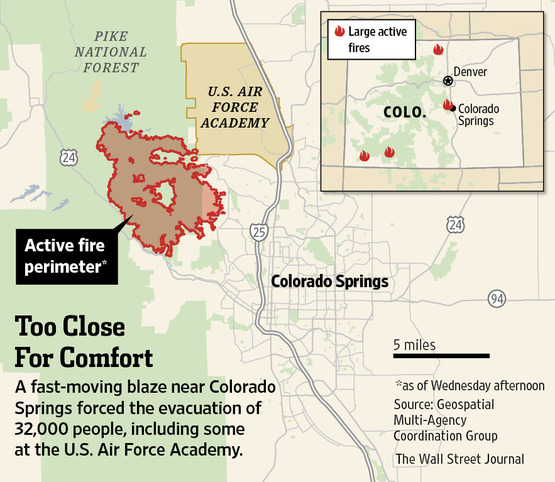By NATHAN KOPPEL
Colorado authorities facing another day of scorching heat on Wednesday continued to battle wildfires that already have destroyed hundreds of homes, threatened some of the state's largest cities and forced more than 32,000 people in Colorado Springs to evacuate.
A fire raging on forest land near Colorado Springs—the state's second-biggest city, after Denver—has consumed more than 5,000 acres since it began on Saturday, fueled by high temperatures, strong winds and dry conditions. Known as the Waldo Canyon fire, it required the nearby U.S. Air Force Academy to suspend normal business operations Wednesday after prompting some evacuations there.
More people are likely to evacuate the city in the days to come, said Anne Rys-Sikora, a spokeswoman for the U.S. Forest Service, adding that forecasts call for possible lightning strikes in the area, which could cause the fire to spread. There is too much smoke to allow for an aerial survey of the damage, she said.
The White House said President Barack Obama would tour the affected area on Friday.
Colorado Springs resident Tom Davis, 70 years old, said he loaded up his motor home and left town Saturday when he saw a menacing plume of smoke in the distance. "We couldn't tell if the fire was three miles or 15 miles away, but it looked pretty darn serious," Mr. Davis said.
At least four other wildfires are burning in Colorado. More than 3,000 firefighters and other personnel are battling the fires.
Several factors have combined to make the Western U.S. a breeding ground for wildfires this year, including an unusually light snowfall this past winter that left trees and brush drier than normal. Wildfires raced through southeastern Montana on Wednesday, torching more than 125,000 acres and straining firefighting resources, the Associated Press reported. Utah and New Mexico have also been scarred by sizable forest fires this month, though none have resulted in multiple deaths.
In New Mexico, a blaze dubbed the Whitewater-Baldy fire is the largest in state history, having burned nearly 300,000 acres. Another, called the Little Bear fire, is the most destructive in the state's record books. It has burned for weeks near the town of Ruidoso and has leveled more than 250 buildings.
"We will not be able to totally control the fire until we get substantial rain, and none is expected at the moment," said Karen Takai, a New Mexico-based fire-information officer with the U.S. Forest Service. While some thunderstorms have blown through, she added, the accompanying lightning "causes more havoc."
Due to abnormally hot and dry conditions, New Mexico this month imposed restrictions on smoking, campfires, and fireworks.
The Waldo Canyon fire near Colorado Springs "has a lot of potential for a lot of threat to public safety," said Richard Homann, Fire Division Supervisor for the Colorado State Forest Service.
He said Wednesday that it would be difficult to make headway against the fire, which is only minimally contained. "The focus with the Waldo fire is defensive—to make sure that people are gotten out of the way and to save homes," Mr. Homann said.
Near Fort Collins, a separate blaze known as the High Park Fire is raging for a third week. It already ranks among the worst in Colorado's history, having destroyed more than 250 homes and killed a woman whose home was engulfed by flames soon after the fire began on June 9.
Conditions have improved for personnel battling the High Park Fire, with the temperatures and winds expected to ease.
"Our hope is that we can improve containment," said Kathy Messick, a spokeswoman with the Larimer County Sheriff's Department.
But, she added, "we have hoped that before and all of a sudden Mother Nature comes up and the wind blows embers in another direction across fire lines and makes it almost impossible to contain."
Write to Nathan Koppel at nathan.koppel@wsj.com


![[image]](https://iza-server.uibk.ac.at/pywb/dilimag/20210113092156im_/http://si.wsj.net/public/resources/images/OB-TN669_0626wi_G_20120627000201.jpg) Matthew Jonas/Longmont Times-Call/Associated Press
Matthew Jonas/Longmont Times-Call/Associated Press

![[SB10001424052702304058404577492440605766680]](https://iza-server.uibk.ac.at/pywb/dilimag/20210113092156im_/http://s.wsj.net/public/resources/images/OB-TN658_0626wi_D_20120626235225.jpg)







![[image]](https://iza-server.uibk.ac.at/pywb/dilimag/20210113092156im_/http://si.wsj.net/public/resources/images/WO-AK240_EUSUMM_A_20120627172932.jpg)
![[image]](https://iza-server.uibk.ac.at/pywb/dilimag/20210113092156im_/http://si.wsj.net/public/resources/images/OB-TN840_0627ne_A_20120627133659.jpg)
![[OB-TK448_0618sc_C_20120618103236.jpg]](https://iza-server.uibk.ac.at/pywb/dilimag/20210113092156im_/http://si.wsj.net/public/resources/images/OB-TK448_0618sc_C_20120618103236.jpg)
![[image]](https://iza-server.uibk.ac.at/pywb/dilimag/20210113092156im_/http://si.wsj.net/public/resources/images/PJ-BI178_CRANKY_C_20120627180844.jpg)
![[image]](https://iza-server.uibk.ac.at/pywb/dilimag/20210113092156im_/http://si.wsj.net/public/resources/images/PJ-BI161_ASKTER_C_20120627170756.jpg)
![[image]](https://iza-server.uibk.ac.at/pywb/dilimag/20210113092156im_/http://si.wsj.net/public/resources/images/OB-TN512_fruits_C_20120626171833.jpg)
![[image]](https://iza-server.uibk.ac.at/pywb/dilimag/20210113092156im_/http://si.wsj.net/public/resources/images/MK-BV268_AMAZON_C_20120626170823.jpg)





Most Recommended
“If there is nothing to hide, the...;”
“Mr Harrop: With due respect, I...;”
“Ms Noonan...Apparently you have...;”
“"The Attorney General is...;”
“The left's demonization of...;”